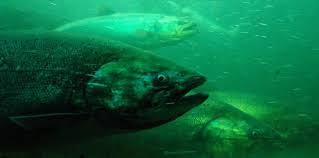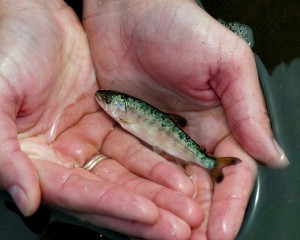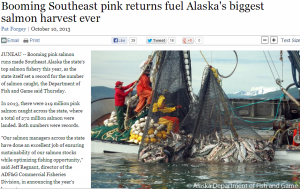
Salmon Offshore Lives Most Critical To Survival – PLOS paper
A tour de force scientific paper published in the Journal PLOS One confirms the critical role ocean pasture conditions have on salmon returns.
Scientists have long known that ocean conditions are perhaps the most important factor in salmon survival. After all salmon put on less than 5% of their adult weight in freshwater while salmon offshore put on 95% of their body weight so it stands to reason that the ocean life of salmon must be key.
A team of scientists from NOAA and Oregon State University have now found that Pacific ocean conditions are far better predictors of adult salmon returns to the Columbia River than 31 other factors, including previous year’s returns or regional physical conditions such as off-coast upwelling.
Biologists on the study showed that survival through the first 6-12 months in the ocean really sets the bar for how many Chinook and coho adults will likely return as adults. Plentiful food on their ocean pasture, especially copepods, is the most important in their first year of life in the ocean, when the young fish are most vulnerable to predators.
The NOAA Science Center has found that it can predict the size of salmon return in any one year with a good degree of accuracy based on the ocean conditions 2-3 years before. (For more on NOAA’s Ocean Indicators analysis, see NOAA’s webpage.)
Multivariate Models of Adult Pacific Salmon Returns (Columbia River And Nearby Salmon Cohorts)
- Brian J. Burke et al, Published: January 11, 2013, DOI: 10.1371/journal.pone.0054134
Abstract: Pacific salmon abundance has been highly variable over the last few decades and most forecasting has proven inadequate, primarily because of a lack of understanding of the processes affecting variability in survival. Better methods and data for predicting the abundance of returning adults are therefore required to effectively manage the species. We combined 31 distinct indicators of the marine environment collected over an 11-year period into a multivariate analysis to summarize and predict adult spring Chinook salmon returns to the Columbia River in 2012. In addition to forecasts, this tool quantifies the strength of the relationship between various ecological indicators and salmon returns, allowing interpretation of ecosystem processes.
Some key bits from the extensive paper include:
“The relative importance of indicators varied, but a few trends emerged. Adult returns of spring Chinook salmon were best described using indicators of bottom-up ecological processes such as composition and abundance of zooplankton and fish prey as well as measures of individual fish, such as growth and condition. Local indicators of temperature or coastal upwelling did not contribute as much as large-scale indicators of temperature variability, matching the spatial scale over which salmon spend the majority of their ocean residence. Results suggest that effective management of Pacific salmon requires multiple types of data and that no single indicator can represent the complex early-ocean ecology of salmon.”
“The adult spring run of Chinook salmon (Oncorhynchus tshawytscha) in the Columbia River, U.S.A. is comprised mostly of hatchery fish , but also includes wild fish from Evolutionarily Significant Units (ESUs, which are the basic management unit for Pacific salmonids) listed under the Endangered Species Act. After spending a year in freshwater, these fish migrate downstream and spend one to five years in the ocean, though the majority come back to the Columbia River after two years.”
“Recent research has shown that juvenile salmon survival in the first few months after leaving freshwater is one of the largest determinants of cohort size. Although size-selective mortality occurs at least through the first ocean year specific mechanisms of mortality are not well described, making estimates of the number of fish returning to the river elusive. Harvest of adults is divided among Native American ceremonial and subsistence, recreational, and commercial fisheries.”
“The harvest allocation and schedule incorporates a sliding scale, dependent on the total run size of upriver spring Chinook salmon. Therefore, a pre-season forecast of the number of adult fish returning to the Columbia River is required each year to determine harvest quotas for the various user groups.”
“Our goal was to determine the best combination of indicators to explain the abundance of spring Chinook salmon returning to the Columbia River each year. The multivariate techniques we used resulted in two important products: a pre-season forecast of adult salmon returns, primarily for management of the fisheries, and a measure of indicator importance, which can improve understanding of ocean ecology and guide future marine research.”
“Most interior Columbia River spring Chinook salmon enter the ocean in May or June and migrate north along the coast to Canada and SE Alaska. Juvenile fish from the Upper Columbia River spring and the Snake River spring/summer Chinook salmon ESUs have similar marine distributions shortly after ocean entry (David Teel, NOAA Fisheries, unpublished data). This suggests that the marine environment could have a comparable influence on their growth and survival an example of this is seen in sockeye salmon.”
Ed note: We find this paper has some remarkable connections to our own studies of salmon offshore based on our unique large scale ocean trials to replenish and restore ocean salmon pastures. Indeed the evidence is clear from our work that when the ocean pastures are restored salmon survival and returns are restored to historic highs. The spectacular returns of Northern Pinks last fall (2013) and this years record runs of southern salmon fit well with the ocean pasture model we have created.
Here’s a couple of links also telling the story of salmon responding to restored ocean pastures.
Record salmon prediction brings expanded sport fishing to Columbia … The Oregonian-Apr 11, 2014 An unprecedented and unexpected fall salmon forecast has anglers and biologists alike excited – enough to allow some of the most liberal summer and fall …
In Alaska last fall the catch of salmon breaks more than 120 years of records.










